
10 July 2023
Take a deep breath of fresh air at Oirase Gorge or Lake Ogawara. Get your fill of nature and cuisine on a summer retreat to Aomori.
Experience the breathtaking nature of the southern Aomori! Plus, the staff at JR East Hotel Mets Hachinohe will point you to a destination where you can escape the heat of summer and enjoy a pleasant holiday. Taste the delightful local gourmet cuisine born from the rich history and culture of each region. The art and science museums offer experiences beyond anything you can imagine.
Table of Contents
- 1Oirase Gorge
- 2Oirase Mossball Workshop
- 3Tsukasa Towada Barayaki Taishu Shokudo
- 4Towada Art Center
- 5JR-EAST HOTEL METS HACHINOHE
- 6Ogawara Lake Kayak Lab
- 7Misawa Aviation Science Museum
- 8Roadside Station Misawa Kureba Park
- 9Kabushima Shrine
- 10Korekawa Archaeological Institution, Hachinohe City Buried Cultural Property Center
- 11Hasshoku Center
- 12Hachinohe Portal Museum "hacchi"
- 13Youtree Souvenir Shop
Oirase Gorge
An iconic, scenic spot in Towada-Hachimantai National Park
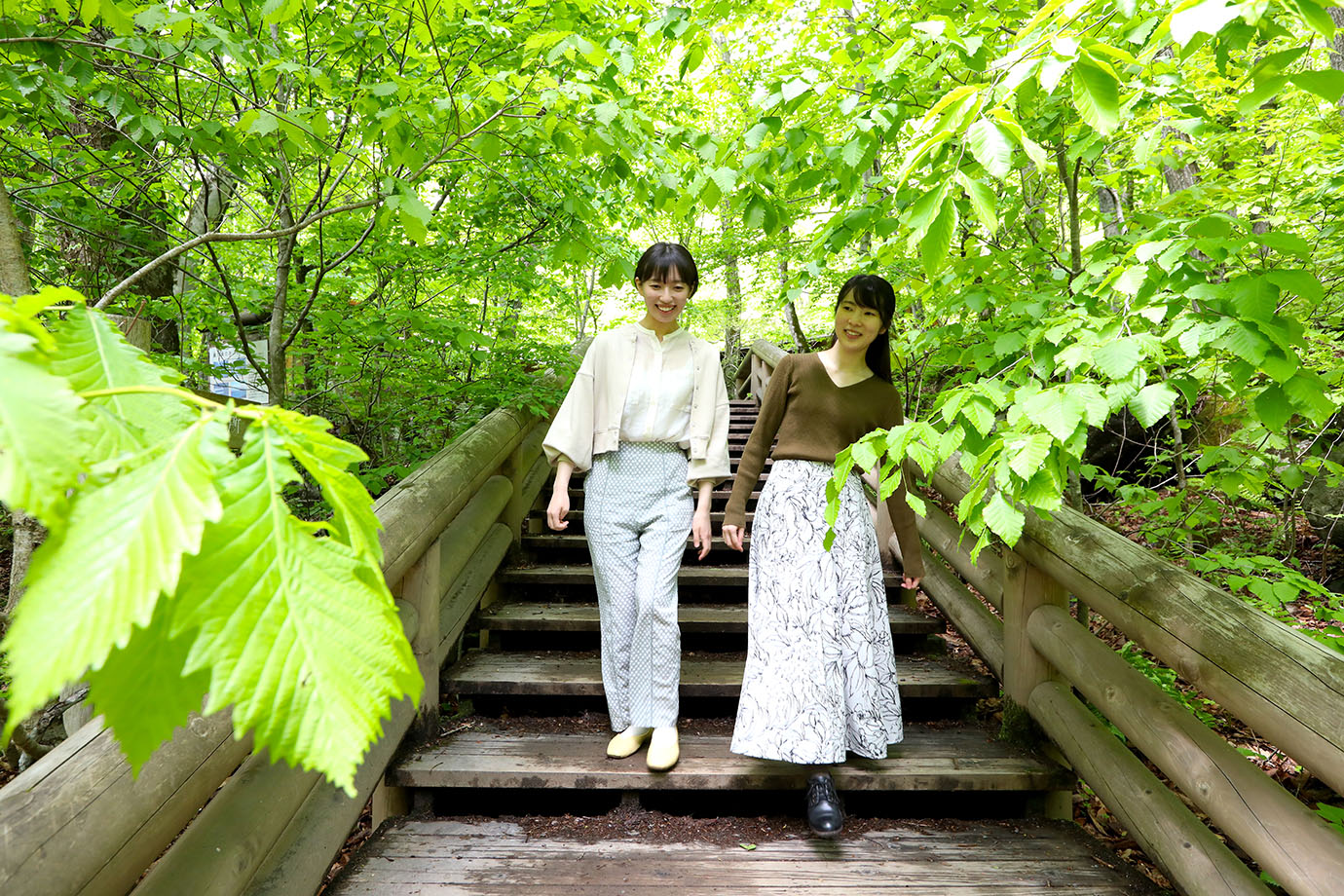
Lake Towada is located on the border between Aomori and Akita Prefectures. The river that runs through Oirase Gorge flows out of Lake Towada and extends for about 14 km to Yakeyama. In early summer, the surrounding trees are overgrown, making it feel as if you were walking through a green tunnel. Follow the path while listening to the murmuring stream for a pleasant stroll along the water.

On this journey, we set out from Ishigedo, where there is a parking lot. In Ishigedo, there is a natural hut made of a massive stone slab ten meters wide and one meter thick, which leans against a katsura tree. Legend has it that a band of female thieves once lived there, ambushing travelers who were passing through. Near this hut, you will find a quiet, clear stream.
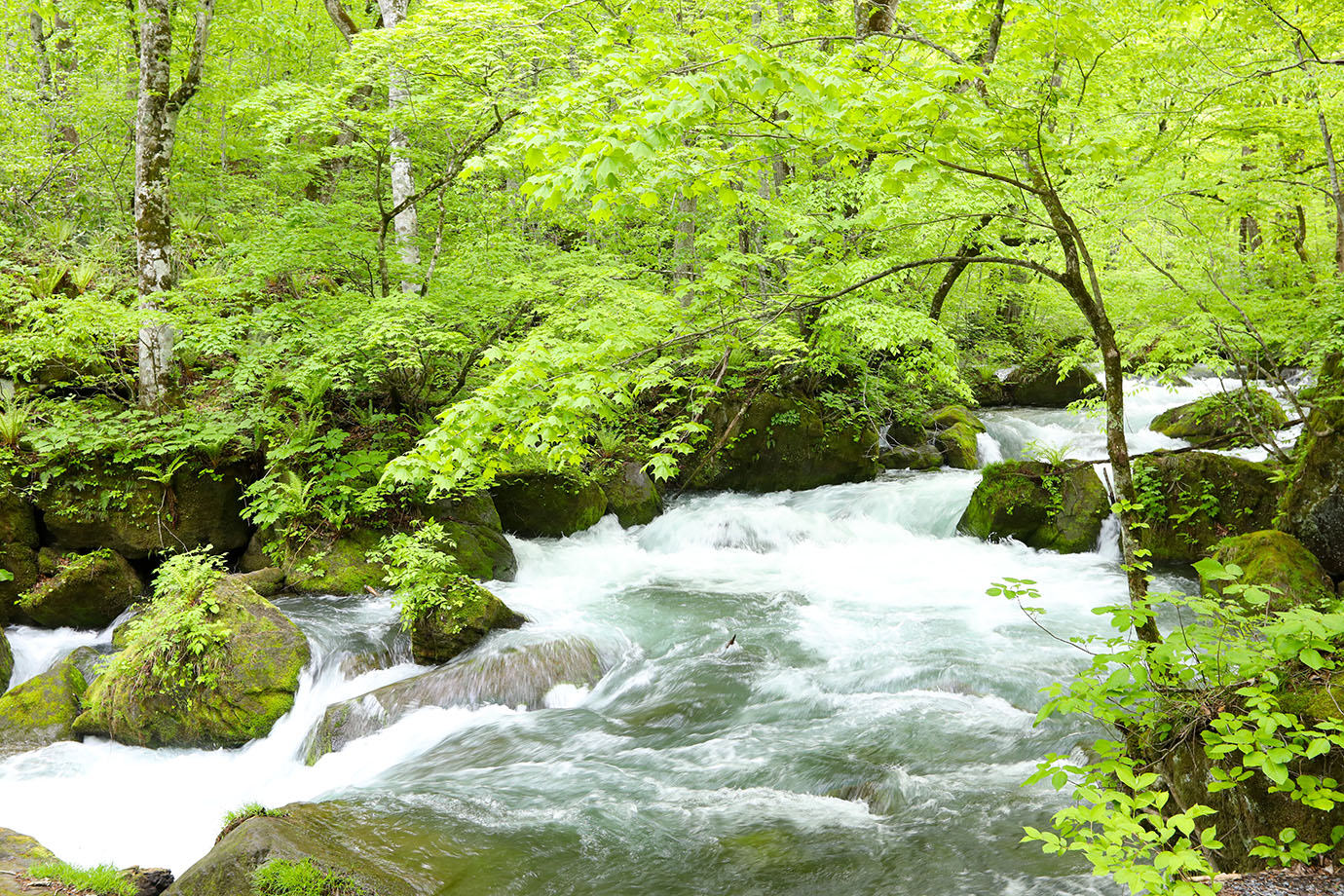
The Ashura Rapids are one of the highlights of the Oirase Gorge. As the name suggests, the way the water splashes as it flows violently between the trees is a spectacular sight. This spot is a favorite that has been featured on TV programs and posters. It is bustling with people painting watercolors and taking pictures in front of the Ashura Rapids.
Dynamic Choshi Falls, a top attraction in the area

Seven meters high and 20 meters wide, Choshi Falls is the most spectacular waterfall along the main course of the Oirase Gorge. As large wafts of fog rise from the cascading waterfall, the sun shines through the trees, creating the beautiful spectacle of water intertwined with light. This waterfall is also known as Uodome no Taki ("fish-barricade falls") because it prevents the fish that swim upstream the Oirase Gorge from reaching Lake Towada.

The water level of the Oirase Gorge is constant, so the stream and the walking path are almost at the same level, allowing you to see the moss-covered rocks and water from up close. Enjoy the dynamism of nature by touring the best spots along the gorge, including its numerous waterfalls and massive boulders.
Oirase Keiryu Stream
Address:Okuse, Towada-shi, Aomori
Phone:0176-75-2425 (Towadako General Information Center)
Fee:None (free walking course)
Hours:None (free walking course)
Oirase Mossball Workshop
Experience the mysterious world of Oirase through mossballs full of life

Oirase Mossball Workshop was founded by Mr. Okita, a former professional wrestler. As the name suggests, mossballs are round objects made of moss. These moss-covered rocks are made to look like a miniature Oirase, using the local moss, trees, and ferns as a reference.

In addition to displaying and selling finished mossballs, the workshop also offers a handmade mossball creation experience. The staff will guide you through the process, so even small children can enjoy the workshop. You start by picking a seedling to be used to make a mossball from a choice of beech, fern, katsura, and Japanese maple.
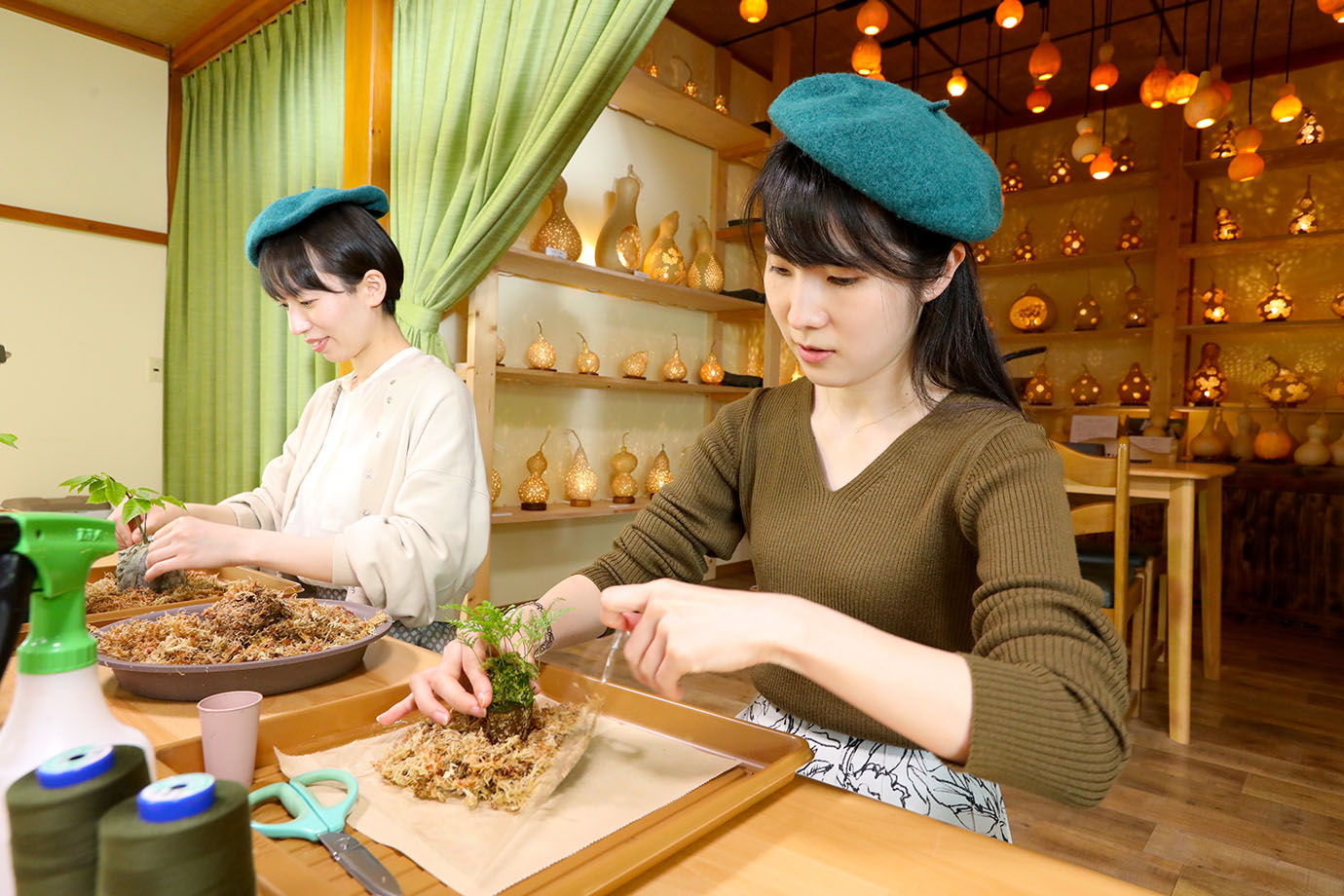
Put on a green beret during the experience so you can feel like you’ve become a mossball yourself! Wrap sphagnum moss around the roots of the seedling and make the whole thing round. Without putting in too much or too little strength, we squeeze the moss to mold it into a ball. Once the shape is formed, we fix the sphagnum moss in place using thread to prevent it from coming off.

Sprinkle water on the moss, which has become like a sheet, and stick it to the roots of the seedling when it becomes soft. If you continue adjusting the shape, it will begin to look a lot like a mossball.
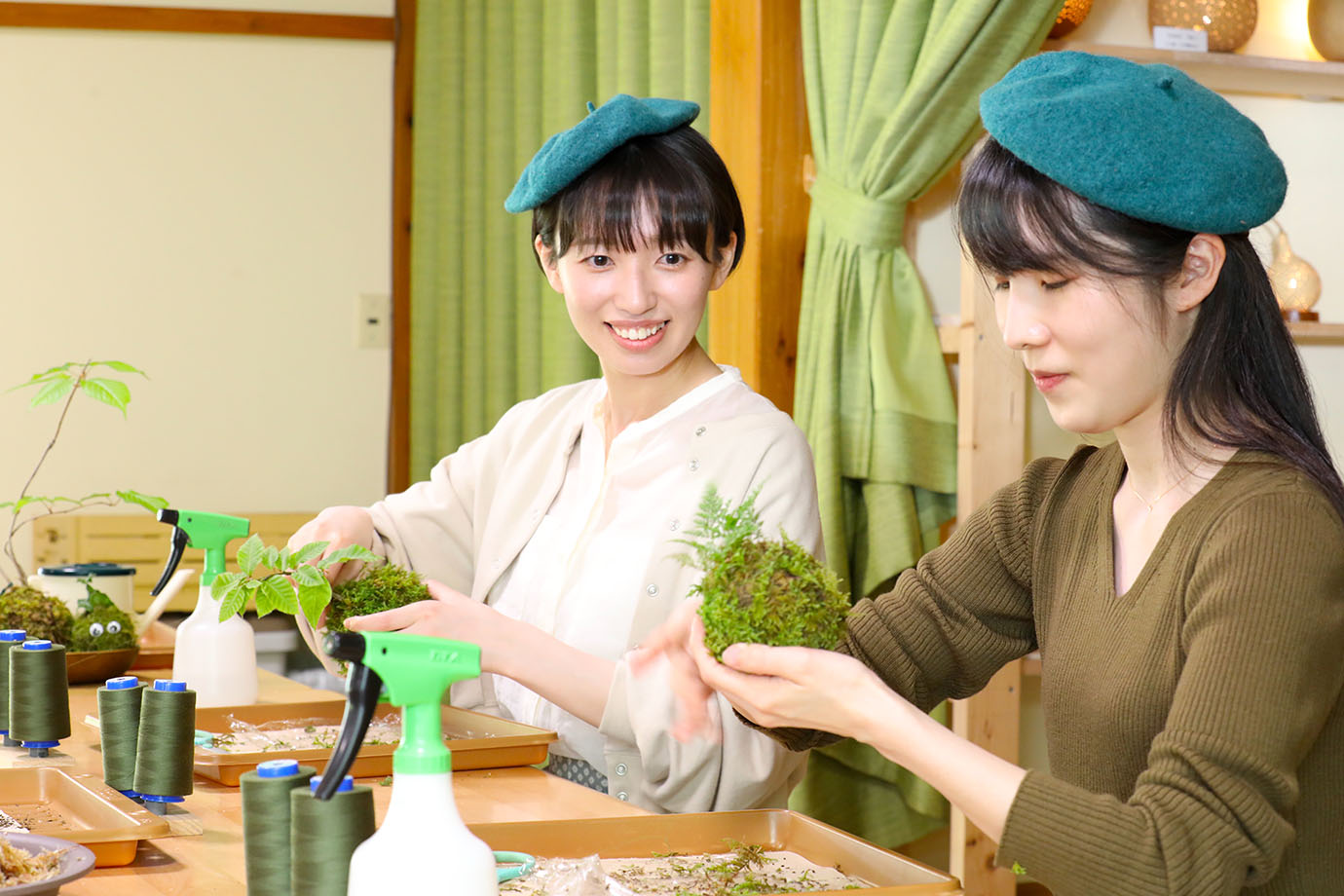
They say that all of the seedlings and moss used for the mossballs are purchased from contract farmers. As you touch the seedlings and the moss, you feel more and more attached.

Once you have added the eyes, you have yourself an adorable mossball! After you take it home, spray it with water to prevent it from drying out. The bright-eyed mossball will remind you of the rich nature of Oirase Gorge.
A journey through a magnifying glass into a microscopic world full of life

In one corner of the workshop, there is a spot where you can observe moss. If you zoom in on the moss with a magnifying glass, you will see that the little moss is as full of life as a tree or a meadow. Explore the microscopic world as if you were walking through a forest of moss species like Hypnum plumaeforme, Bartramia pomiformis, and Racomitrium canescens.

Alongside this workshop is another, the Oirase Lamp Workshop. Here, holes are made in homegrown gourds, and light is added to create a "miniature Oirase." The workshop sells gourd lamps and offers a lamp-making experience.

A variety of mossballs await in the exhibition and sales space. You’re welcome to stop by just to buy products, too.
Oirase Mossball Workshop
Address:64-195 Horyo-Yakeyama, Towada-shi, Aomori
Phone:080-2165-7454
Fee:From 2,000 yen per person for the mossball experience (around 30 minutes)
Hours:9:00 a.m.–4:00 p.m. (Mossball experience: 9:00 a.m.–3:30 p.m.)
Closed:All winter
Tsukasa Towada Barayaki Taishu Shokudo
Enjoy a rosy life with Towada Barayaki, a taste of home-cooked Towada food!
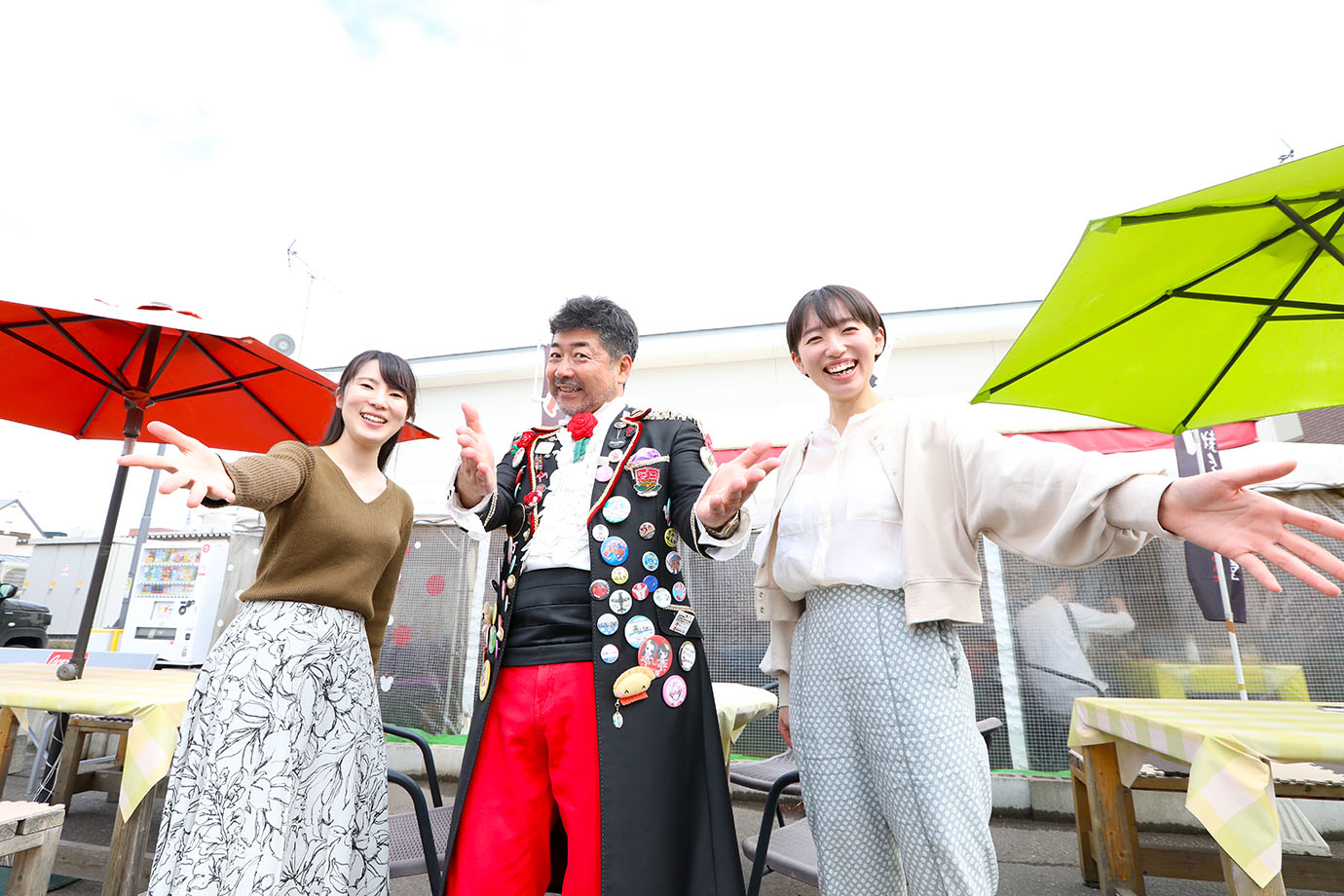
Barayaki is a local gourmet dish in Towada that is cooked with beef or pork ribs and plenty of onions seasoned with a salty-sweet, soy-based sauce and grilled on an iron plate. After the war, it became popular as a dish for the common people, and there are about 80 establishments that serve Towada Barayaki in the city. On this trip, we learned how to eat delicious food from Mr. Hatanaka at the Towada Barayaki Seminar, a local gourmet community development organization.

Towada Barayaki is 800 yen per serving for pork and 1,000 yen per serving for beef. Meat is piled up like a tower in the center and is surrounded by lots of onions. After the onions are thoroughly cooked, the meat is broken up and grilled.
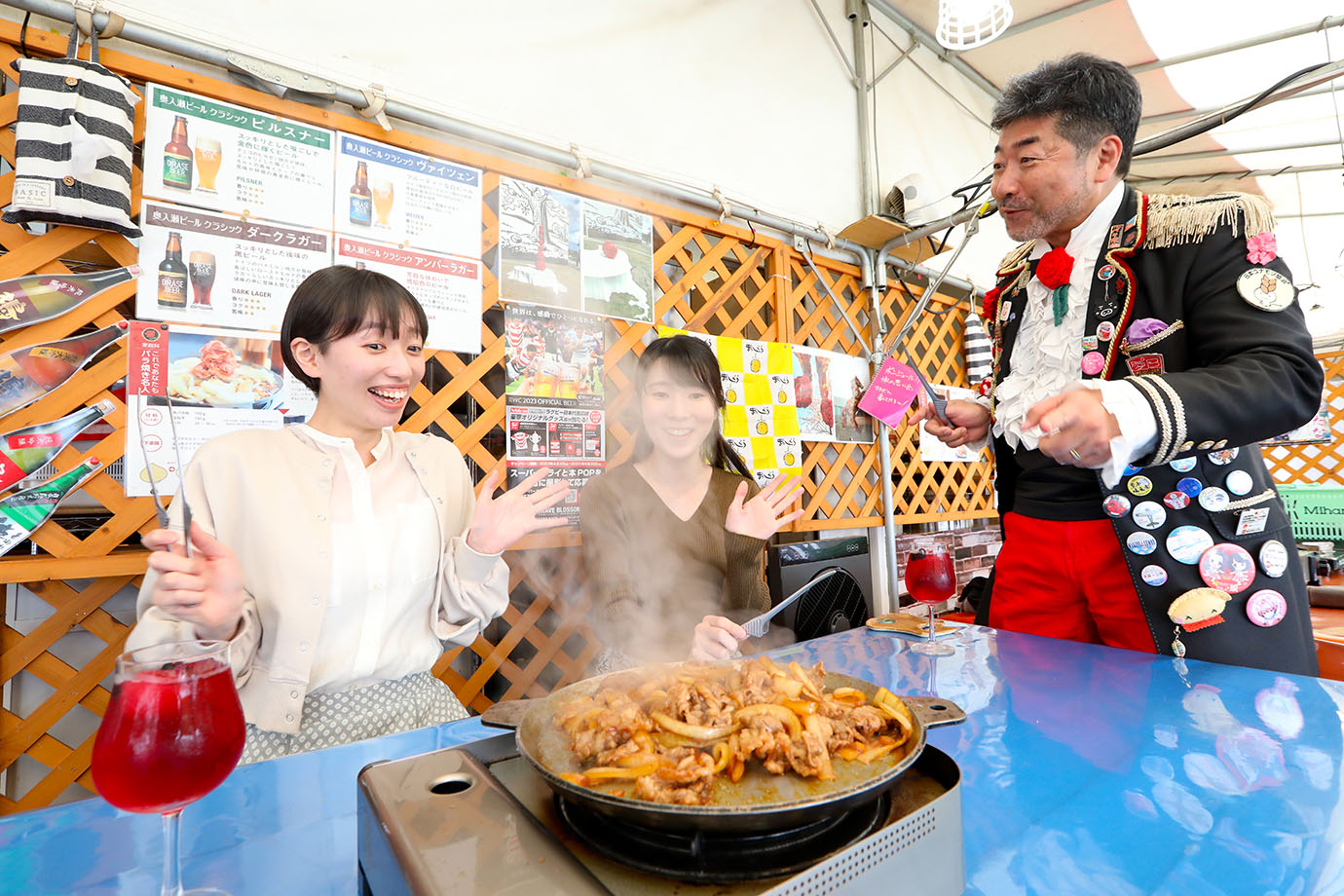
The key is to cook over high heat until the moisture evaporates, but don't overcook the meat. When the heat is turned off, steam rises from the barayaki, which was surprising to see. Because the word "bara" in "barayaki" has two meanings (ribs/roses), Mr. Hatanaka decided on a unique outfit inspired by the French aristocrats in The Rose of Versailles (a popular manga series). At events, he promotes barayaki in his usual formal tuxedo.

As the beef ribs and the sweet and salty sauce mix together, the aroma whets your appetite. The golden brown onions look delectable.
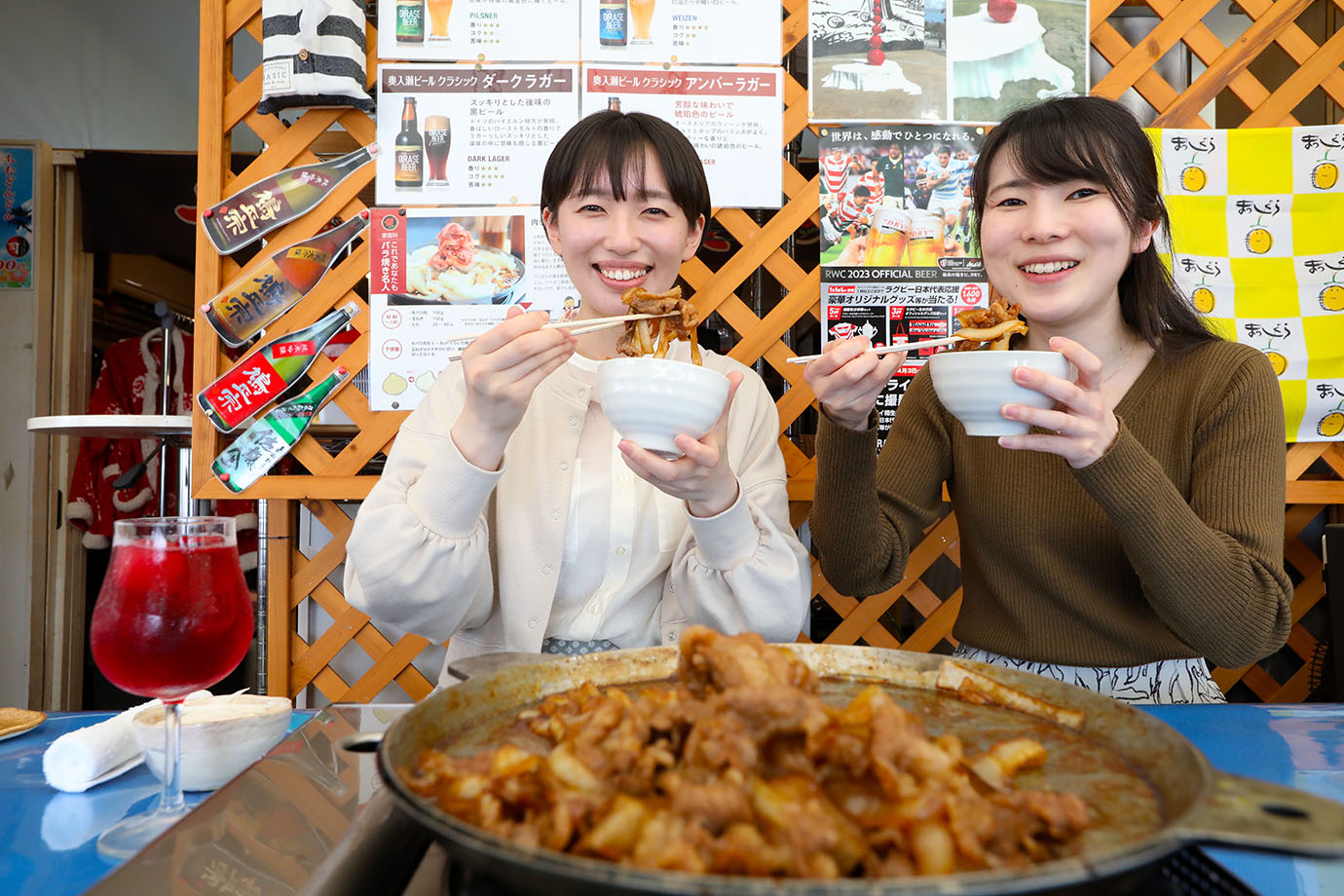
For 1,200 yen, the Towada Barayaki Lunch (beef) comes with rice, soup, and pickled vegetables. The sweet and salty sauce goes well with rice! You are also free to order other toppings, such as raw egg, nagaimo yam, and udon noodles, according to your preference.
They also offer many side dishes such as brand-certified Towada pork and garlic.

Their second most popular dish, Tsukasa Butatanyaki, is 900 yen. The thick cut of tongue is seasoned with Towada garlic and exquisite salt before it is cooked to an irresistible, firm texture.

The Butatanyaki is stylishly presented on plates shaped like Aomori Prefecture. Towada Garlic Pork, a serving of brand-certified pork from Towada raised with garlic powder mixed into the feed, is also recommended at 900 yen, as well as Towada Negiyaki at 350 yen.

This is Bokenabe, a dish that's served only in winter for 1,000 yen per person. Grown in Towada, bokeshirazu-negi (a type of green onion) is characterized by its beautiful contrast of green and white, as well as its sweetness. Enjoy this hot pot dish with ingredients of your choice, such as pork, tofu, wontons, and more.
Tsukasa Towada Barayaki Taishu Shokudo
Address:15-41 Inaoicho, Towada-shi, Aomori
Phone:080-6059-8015
Hours:11:00 a.m.–2:30 p.m., 5:30 p.m.–10:30 p.m.
Closed:Mondays (or the following day when Monday is a holiday), only open for lunch time on Sundays
Towada Art Center
Use all five senses to enjoy contemporary art that spills out into the plaza and the city

Flower Horse by Choi Jeong Hwa
Opened in 2008 as the core facility for Arts Towada, a project that integrates urban development and art, transforming the entirety of Towada's Kanchogai Avenue into an art museum. Each exhibition room is independently arranged as a "house for art," and works by internationally renowned artists such as Yayoi Kusama and Ron Mueck are permanently exhibited in spaces designed for the artwork.

Flower Horse is displayed in an outdoor space that connects to Kanchogai Avenue, formerly known as Komakaido. It's 5.5 meters tall, its body is covered with colorful flowers, and its hooves are made of roses.

Ghost and Unknown Mass by Inges Idee
What's great about this spot is that you can enjoy art casually while taking a walk on the grass, sitting, and chatting. Hovering gently in the back is Ghost, its two black eyes looking out at Unknown Mass. Both were created by the Berlin artist collective Inges Idee.
You just might be able to snap a surprising shot! Dive into the art.

Standing Woman by Ron Mueck
A statue of a woman stands four meters tall, alone in a large space. Even the folds of the clothes and the texture of the hair have been produced very realistically, and it seems as if the woman is looking at something with a melancholy expression. What's mysterious is that no matter what angle you look from, you won't make eye contact.

Edificio — Buenos Aires by Leandro Erlich
Disregard gravity and strike a pose on this much-talked-about work, which is modeled after a familiar building in Buenos Aires. Due to the effect of the mirror installed at a 45 degree angle, a strange scene that defies reality unfolds before you.
Enjoy tea time while looking at works on display outside
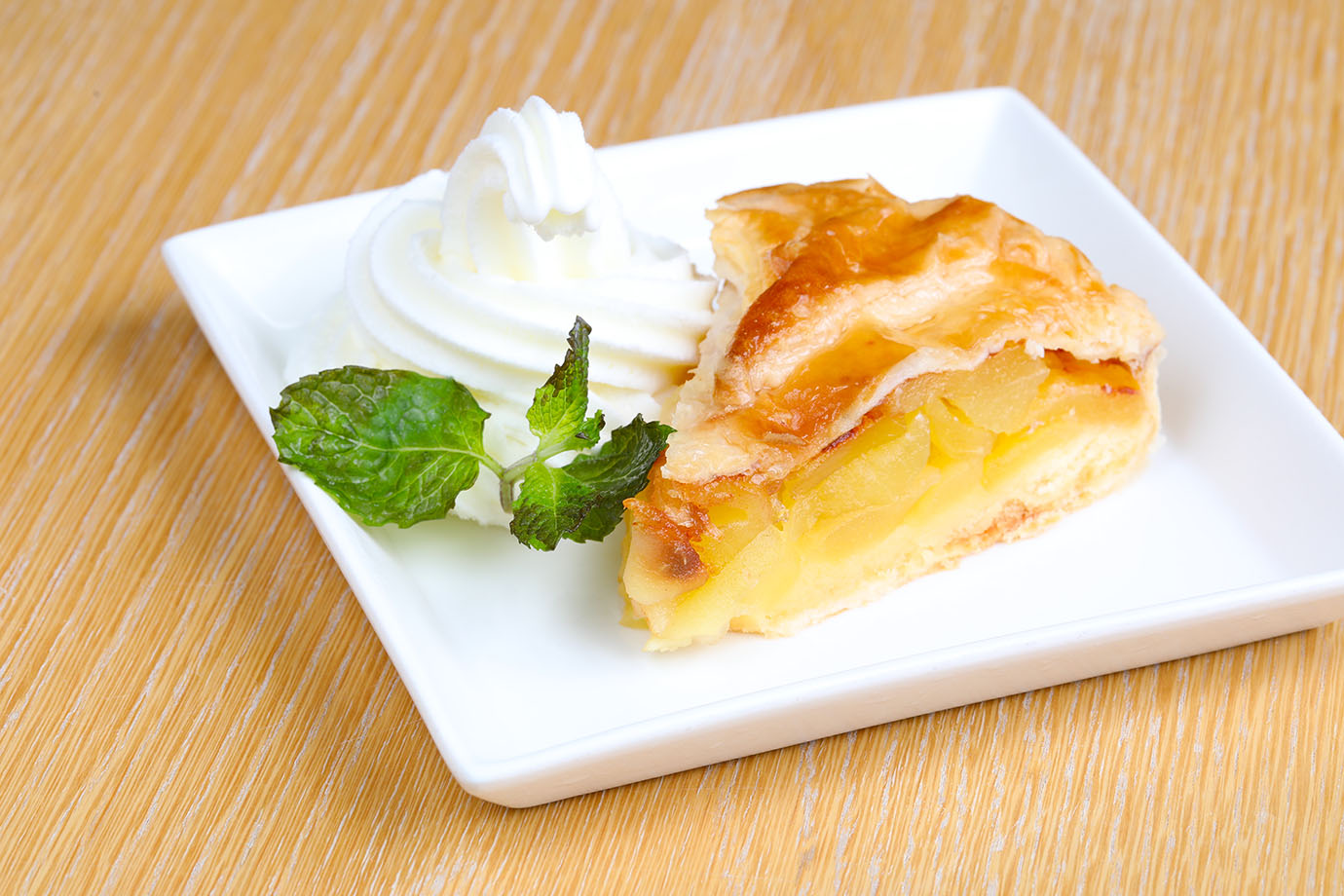
After you've had your fill of art, head to cube, a cafe inside the museum. In this white, square room, you can savor dishes and sweets you'll only find in Aomori or Towada. The apple pie with gelato (700 yen) is made with apple pie from Fukuda Kashiho.

This hot chocolate with marshmallow is 520 yen. Inside the hot chocolate, you'll see cube-kun, the cafe's mascot, smiling at you.

At this special location, you can enjoy sweets while looking out at works of art installed outdoors through the window. They also offer healthy dishes using local ingredients, such as beef pie with Towada short-horn beef and burdock, and pork and apple curry with rice.

The shop features stylish displays of original museum merchandise, designer goods, and Towada crafts. The Yayoi Kusama key rings (left) are 3,520 yen each, and the original mugs (right) designed by Yayoi Kusama are 2,200 yen.
Towada Art Center
Address:10-9 Nishi-nibancho, Towada-shi, Aomori
Phone:0176-20-1127
Fee:1,800 yen for admission (1,000 yen when there are no special exhibitions)
Hours:9:00 a.m.–5:00 p.m.
Closed:Monday (or the following day when Monday is a holiday)
JR-EAST HOTEL METS HACHINOHE
A comfortable space in the station inspired by the seas of Hachinohe

Umineko Plaza, a station building on the east exit side of JR Hachinohe Station, is a complex of city facilities, including the Hachinohe Book Information Center. The front desk is on the 4th floor, and guest rooms are up to the top floor, which is the 8th floor.
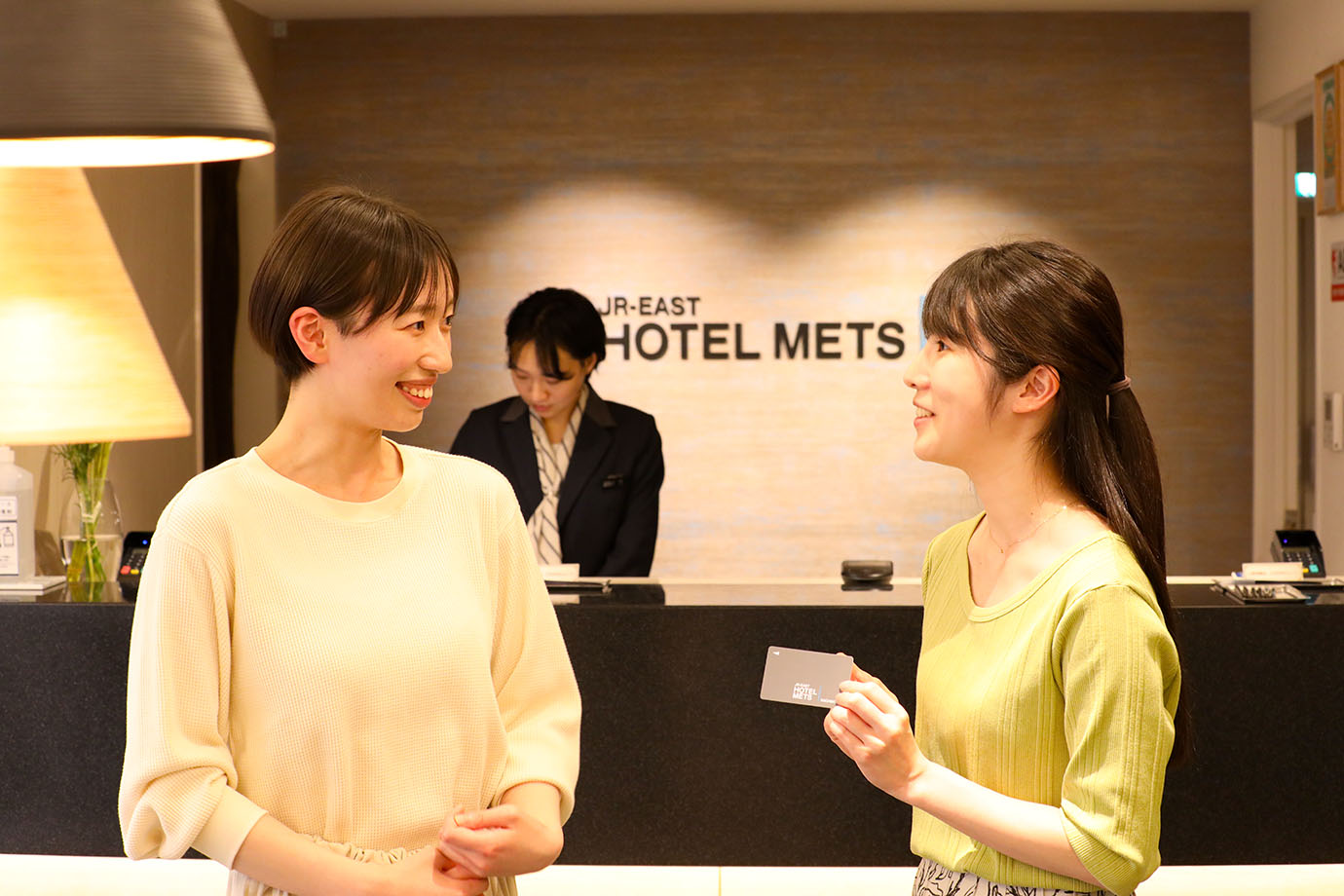
The hotel is inside the station, making it easy for you to check in even on rainy days. Let's pick up our card key and head to the guest room.
Traditional Hachinohe crafts welcome you in the lobby

The spacious lobby is decorated with Yawata horses, a local Hachinohe toy, Nanbu sakiori textiles, Nanbu ironware, and other handicrafts, as well as wooden BUNACO lamps made of beech that hang in the lobby. The interior is decorated in a blue tone that evokes the sea of Hachinohe.

The twin room features an impressive blue interior. The spacious bed is 120 cm in width and boasts a high-density pocket coil mattress made by Nippon Bed Manufacturing Co., Ltd.

The windows are decorated tastefully with lace curtains to create an effect that reminds you of the sea and waves of Hachinohe.
Make your own ochazuke with toppings of your choice!

Breakfast is served at Ikameshiya Horin on the third floor, a buffet of Japanese and Western cuisine cooked using ingredients sourced from Aomori. Have your fill of all-you-can-eat hijiki seaweed, salad, and sembei soup! You can also try their squid dishes, such as squid stewed with innards and radish.

We recommend the Ochazuke Corner. Make your own original ochazuke (rice with tea) using 2 types of dashi (broth)—white dashi and shijimi (clam) dashi—as well as ten different types of toppings. In addition to standard toppings like plum and mustard greens, they offer Hachinohe specialties like canned mackerel.
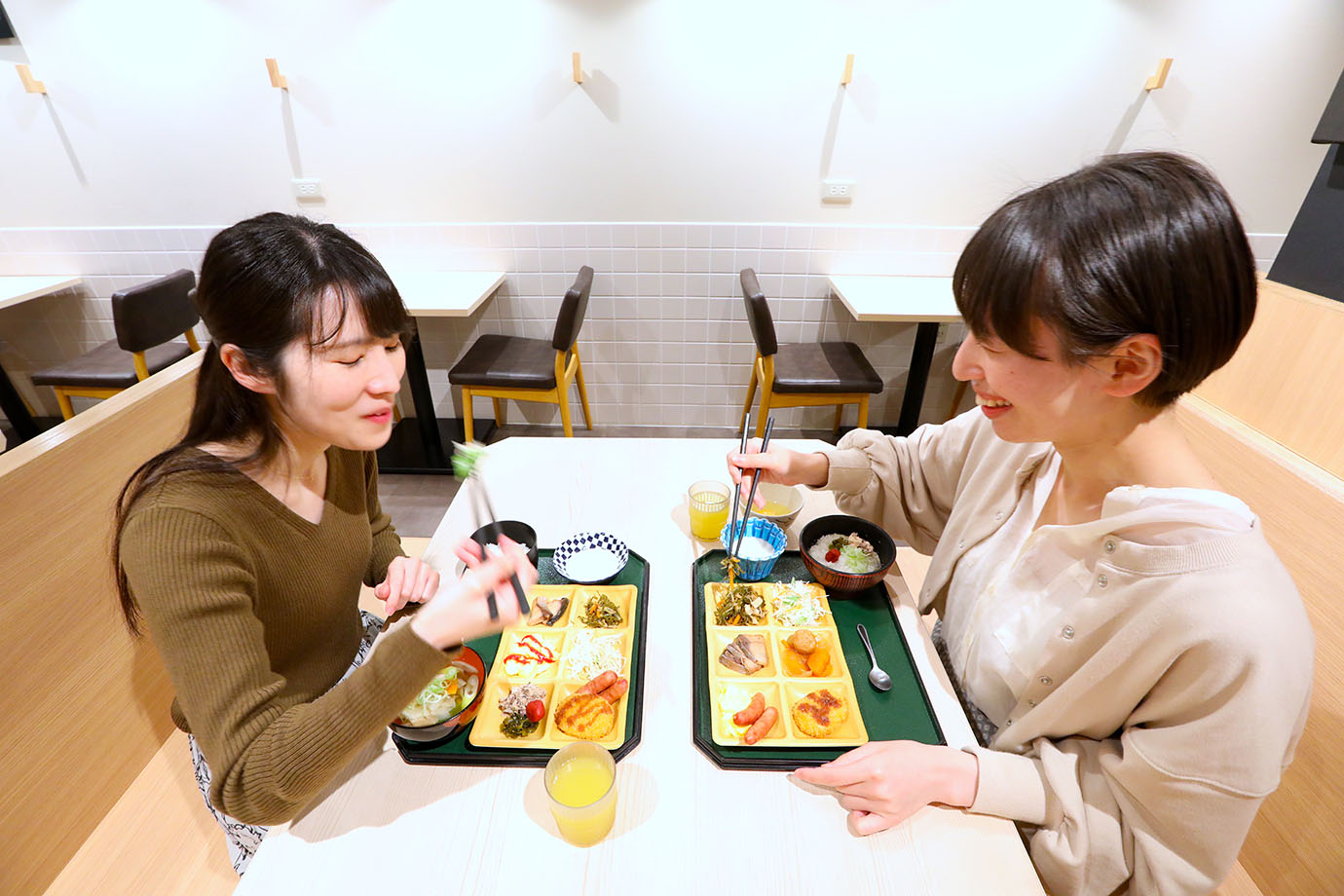
Together with rice, you can enjoy an omelet, cut and dried radish, stew, miso soup, and more for a taste of local home cooking. In the evening, you can enjoy a cup of local sake paired with dishes of your choice, like the seafood bowl filled to the brim with fresh seafood, squid and rice, or grilled hokke fish.
JR-EAST HOTEL METS HACHINOHE
Address:1-1 Tateda, Shiriuchimachi, Hachinohe-shi, Aomori
Phone:0178-70-7700
Check-in:3:00 p.m.
Check-out:11:00 a.m.
Official site:https://www.hotelmets.jp/en/hachinohe/
Ogawara Lake Kayak Lab
At Ogawara Lake Kayak Lab, even beginners can try kayaking at the largest lake in Aomori!

It takes about 40 minutes by car from Hachinohe to reach Lake Ogawara and all its scenic splendor. With an area of 63.20 square kilometers and a depth of 25 meters at its deepest point, Lake Ogawara is the largest lake in Aomori Prefecture. It is also called Takarako ("treasure lake") because of its abundance of freshwater clams and whitebait to catch.

At Lake Ogawara Kayak Lab, you can take part in a kayak tour or an SUP experience. The kayaking experience can be enjoyed by beginners and children in addition to seasoned kayakers. After completing the reception at the Lake Pier of Lake Ogawara Sightseeing Center, put on your life jacket and get ready.

This is the instructor, Mr. Togawa. In addition to Lake Ogawara, he holds various tours in a variety of areas, including Kabushima and the area along the Tanesashi Coast.

First, participants put on their life jackets and take a paddling lecture on land. We check the orientation of the paddles and learn the basic movements to paddle right and left, and so on. Lake Ogawara is shallow, so as a safety instruction, we are told not to panic and to stay where we are if the kayak capsizes.

Next, we actually get on our kayaks and practice paddling. The key is to face forward without looking at your hands and to use your hips to move the paddle instead of relying on the strength of your arms.
Onto the lake while keeping balance
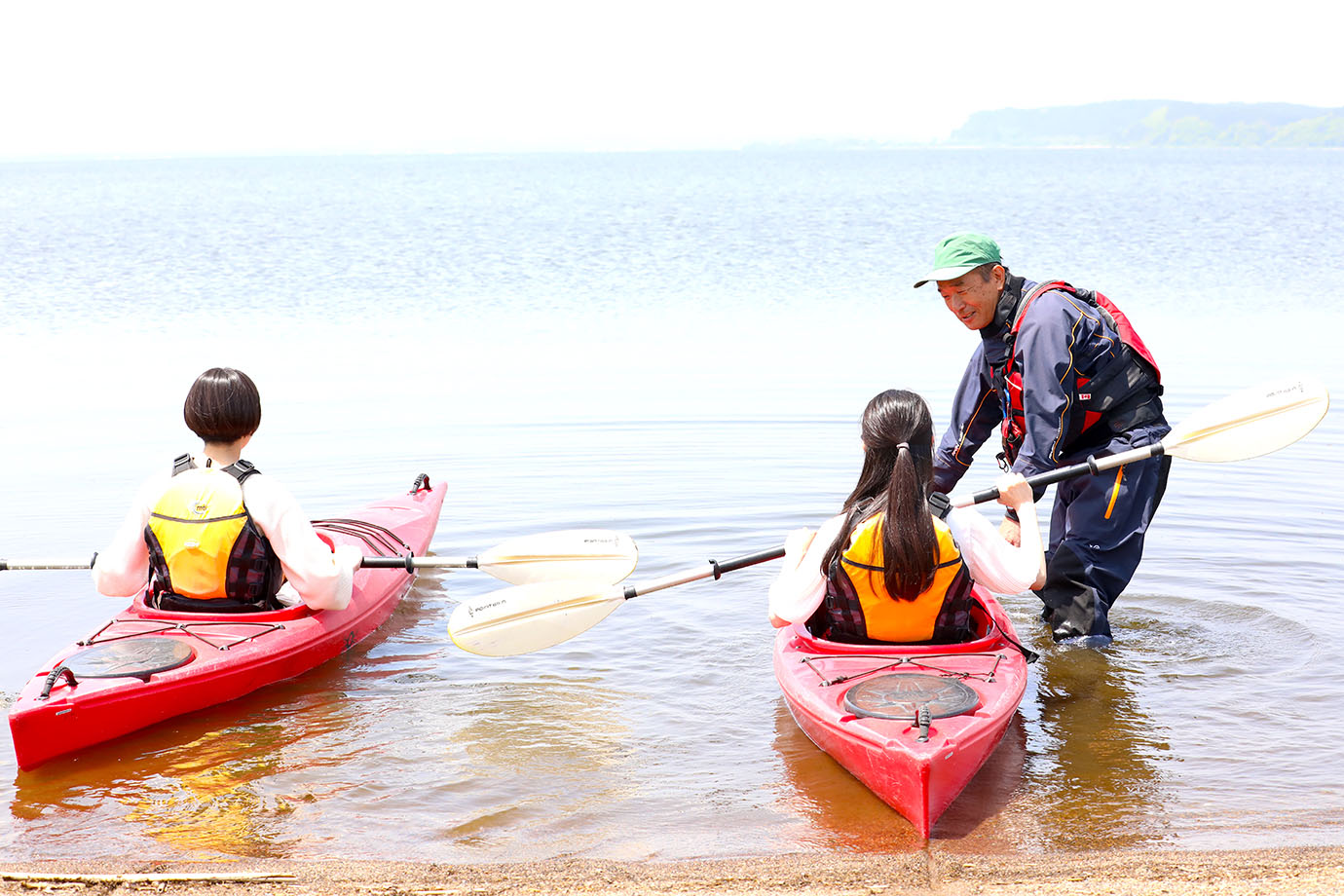
While still on our kayaks, we then went out onto the water. We were nervous about losing our balance on the lake and tipping the kayak over, but we continued paddling slowly and moved forward.

On the day of our visit, Lake Ogawara was calmer than we expected, and there were no waves. While listening to Mr. Togawa's advice, we gradually got used to the paddling motions and started to move in the direction we intended. The kayak is close to the surface of the lake, creating a strange sensation like you're floating between the lake and the sky.
After the kayaking experience, you can also take a tour.

Once you've taken part in the kayaking experience, you can take the full kayak tour. This is a special 2.5-hour tour that takes you past the private beach of the U.S. military base in Misawa and through a jungle-like waterway to Anenuma on the south side of the lake.

Our instructor Mr. Togawa stayed close to us until we got to shore, allowing us to enjoy the experience with peace of mind. Mr. Togawa tells us that he wants as many people as possible to experience the nature of Aomori. The Lake Ogawara Kayak Lab offers SUP experiences, winter ice kayaking, and other programs that allow visitors to get their fill of nature.
Lake Ogawara Kayak Lab
Address:116-2858 Misawa Sabishirotai, Misawa-shi, Aomori
Phone:080-6591-6586
Price:3,500 yen per person for the kayaking experience (high school students and older). Instruction fee, equipment rental fee, insurance fee, and consumption tax are all included.
Hours: 9:00 a.m. to 5:00 p.m. (Kayaking experiences start from 10:00 a.m., 11:30 a.m., 1:30 p.m., and 3:00 p.m.)
Closed:November to April (open daily from July to September)
Misawa Aviation Science Museum
Watch, ride, and learn! To the holy land of aviation enthusiasts

Based on the themes of "the sky" and "flight", visitors can enjoy learning about the role that Aomori Prefecture has played in aviation in the world and the technologies related to aviation. Outside the museum is Misawa's Sky Plaza, where you can enjoy the view of Misawa Air Base and take a look at some historical airplanes.
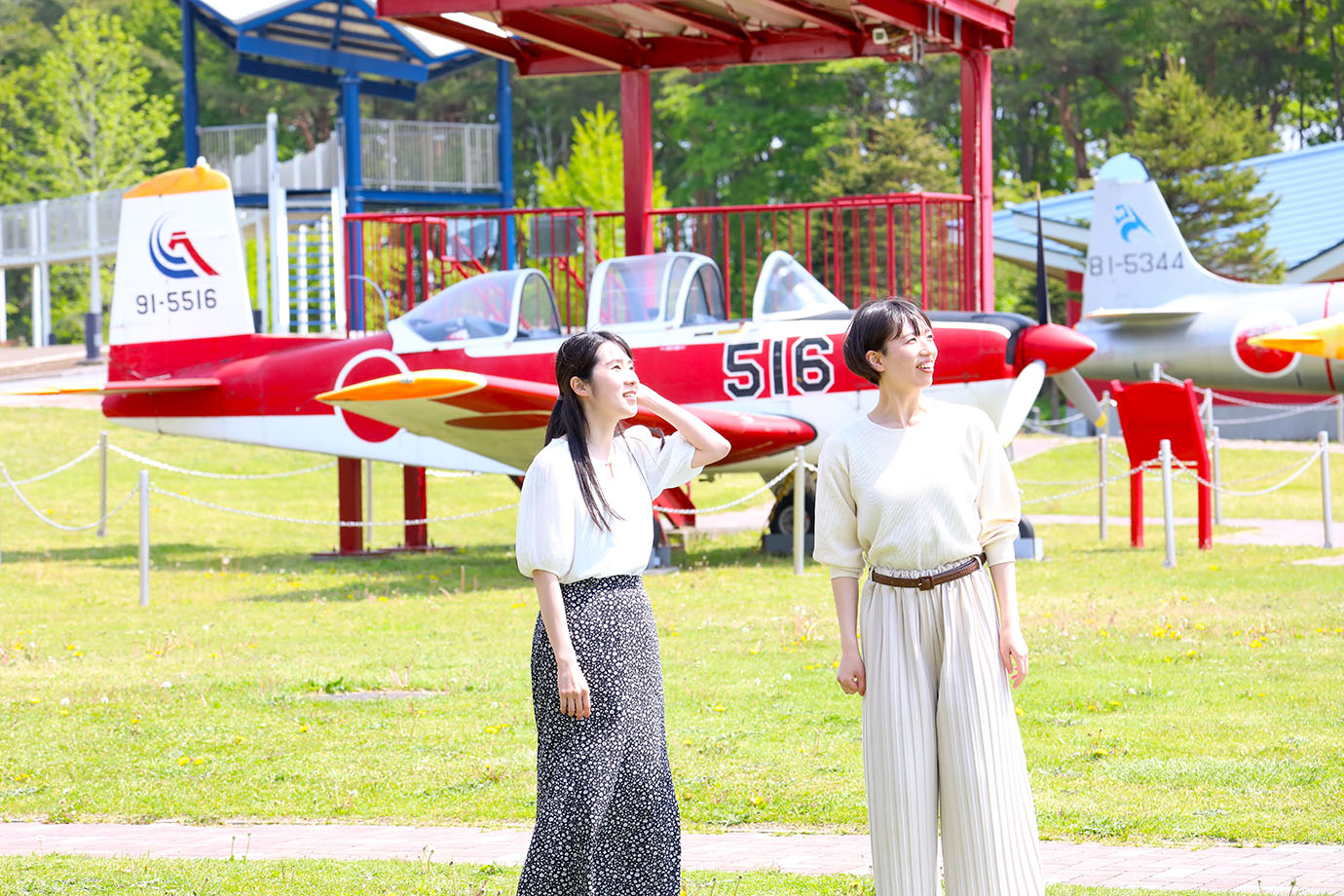
Eleven aircraft that were actually flown actively through the skies are on display at the Sky Plaza. They may all be aircraft, but each of them represents a different time period and purpose. For some of the aircraft, the museum offers boarding experiences and interior tours.
Board the cockpit and feel like a pilot.

The red T-3 was used as a primary trainer for Japan Air Self-Defense Force pilots to fly and undergo training for the first time.

You can also sit in the cockpit of the F-104J. Serving from 1963 to 1986 (standby alert), the F-104 was the first supersonic fighter of the Japan Air Self-Defense Force, with 230 aircraft produced under license. In its day, it set a world record by reaching an altitude of 27.8 km and a speed of 2,250 km/h.

The blue aircraft is a T-2 (dedicated to Blue Impulse). From January 1982 to December 1995, this T-2 served as the Blue Impulse aircraft of the Japan Air Self-Defense Force, and performed exhibition flights at various locations, including the Misawa Air Base Air Festival. There are explanatory panels for each aircraft, but on some days, former pilots visit the museum to provide commentary.
Flying and floating for a thrilling experience at the hands-on exhibition
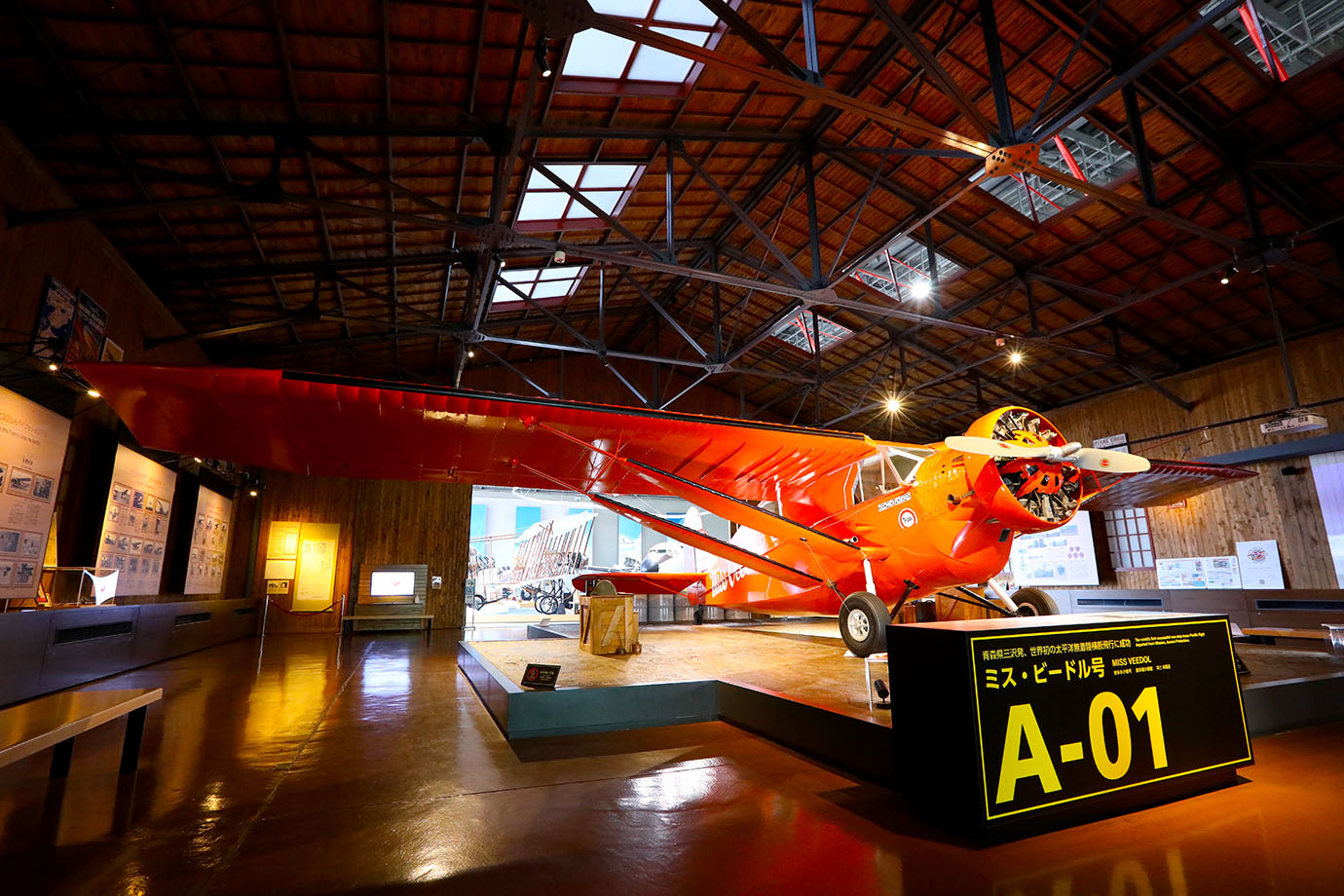
The Misawa Aviation Science Museum is divided into three zones: the Aviation Zone, the Science Zone, and the Space Zone. A full-scale replica of the Miss Veedol, the first plane in the world to fly nonstop across the Pacific from Misawa to the United States, is on display in the Aviation Zone.
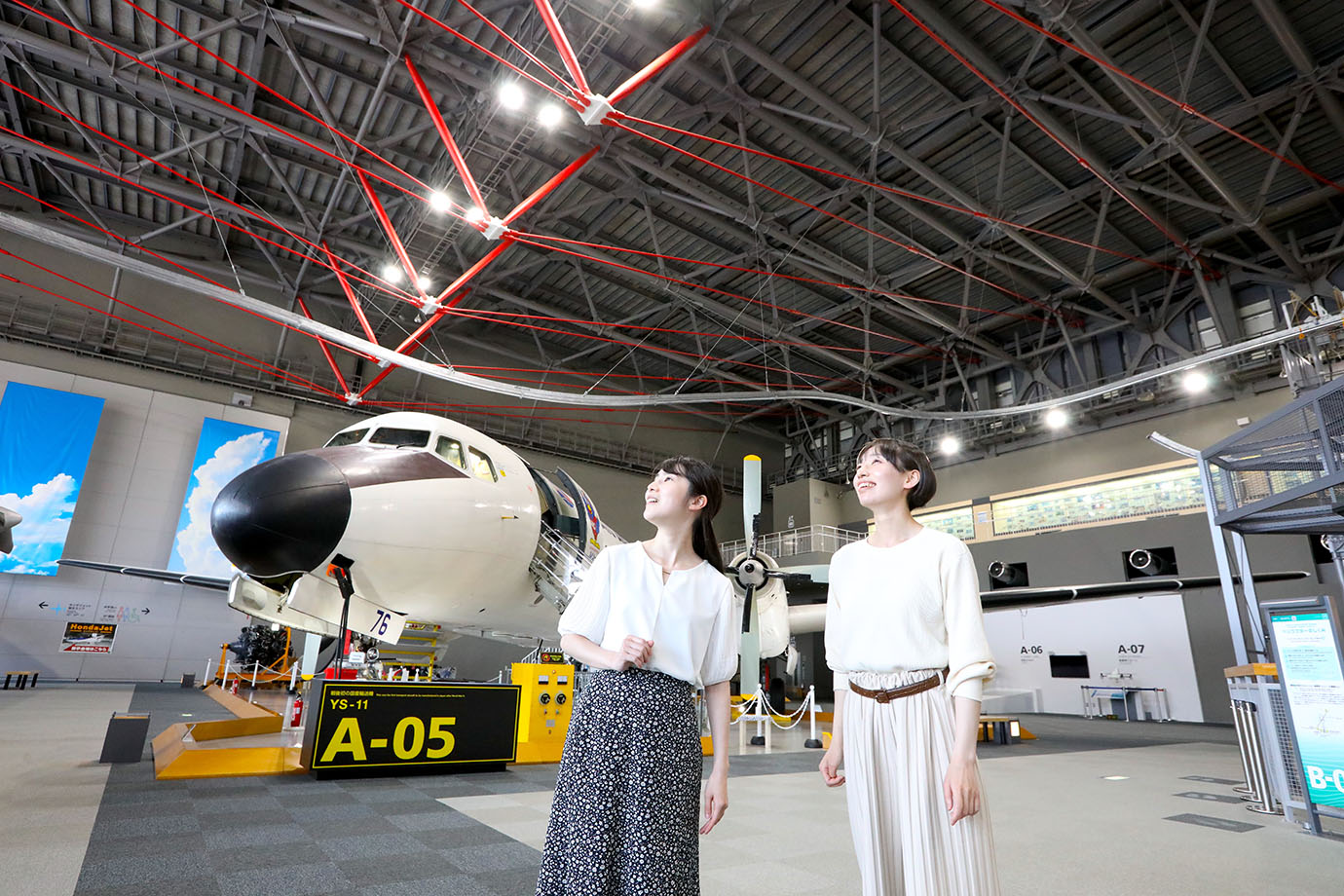
Various other historical aircraft and drones can be seen in the Aviation Zone. The YS-11, the first cargo plane manufactured in Japan after World War II, is pictured in the background. You can see the inside of the cabin and the wheel well.

The full-scale interactive exhibits are a popular attraction at the Science Zone. On our visit, we tried the Let's Fly experience! A rail is installed in the upper part of the museum, and visitors are suspended on a pulley and glide along the rail at a height of approximately 10 meters. There are ups and downs along the way, which made the experience more thrilling than we expected! The museum also offers interactive exhibits that allow visitors to experience the gravitational pull of planets and the sensation of flying and floating, such as the Flight Simulator and Space Exploration Mission experiences. In this museum, adults who love aviation and children who dream of going to space can both lose track of time as they enjoy a fascinating experience.
Misawa Aviation Science Museum
Address:158 Misawa Kitayama, Misawa-shi, Aomori
Phone:0176-50-7777
Fee:510 yen for admission
Hours:9:00 a.m.–5:00 p.m.
Closed:Mondays
Roadside Station Misawa Kureba Park
Taste the Air Force Burger, passed down from an American chef!

Kureba Park, the restaurant at Roadside Station Misawa, offers a wide variety of local dishes made with locally sourced ingredients. You can enjoy Misawa's unique gourmet dishes at reasonable prices, such as the Paika Curry (800 yen), which is made with rare cuts of pork, as well as the Shijimi Ramen (830 yen), which is made with shijimi (clams) from Lake Ogawara.

The must-try dish at this restaurant is Misawa's local specialty burger, known as the Air Force Burger. The chef at Kureba Park completed this invention with help from an American chef at the U.S. military base. Sandwich the thick pate, vegetables, and sauce together between buns that have been toasted to a crisp on both sides, then dig in!

Enjoy your lunch as you bask in sunlight by the window. A tourist information center and a souvenir corner can also be found inside the building.
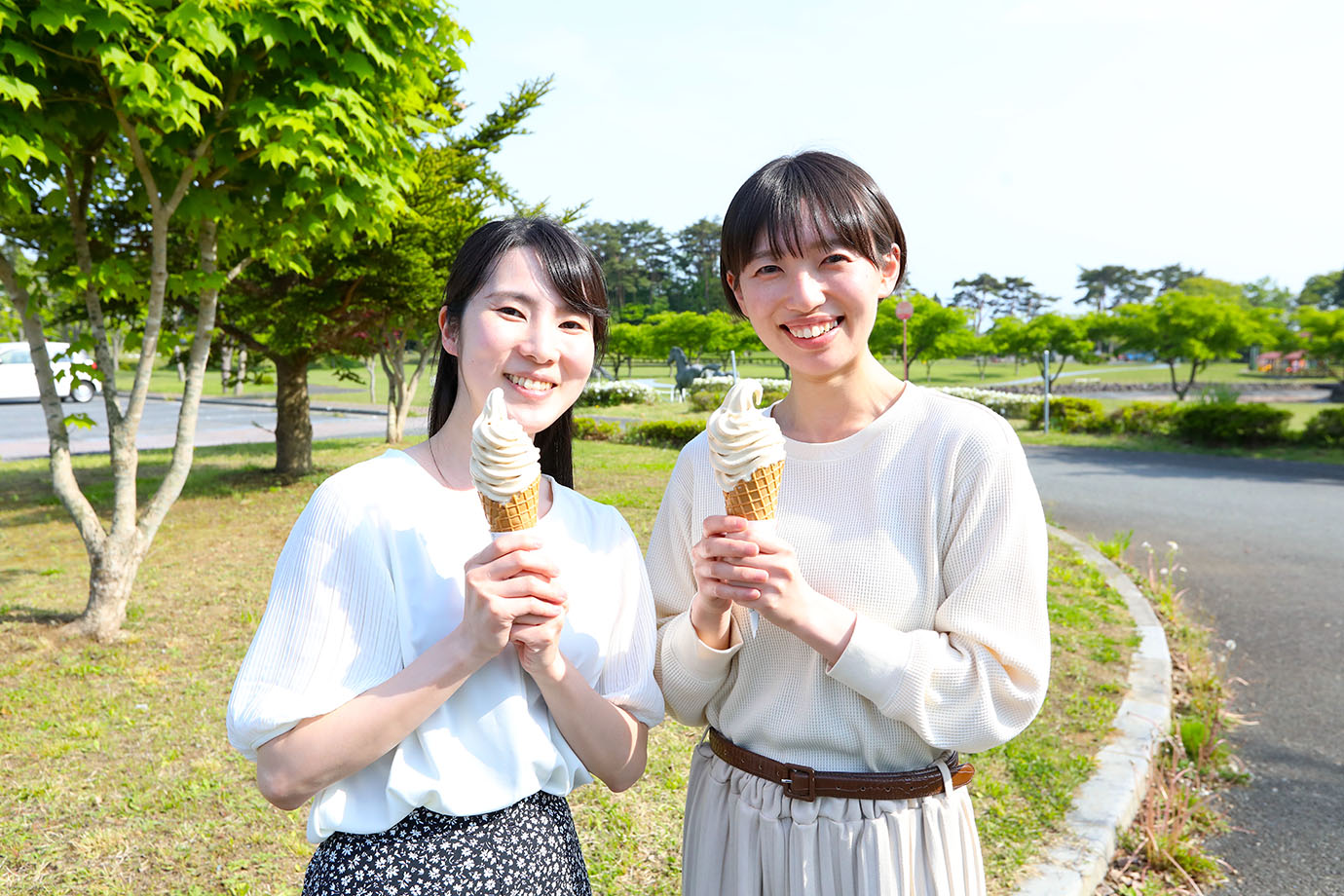
The restaurant offers sweets, too! The burdock tea soft serve ice cream is made from burdock from Misawa, which is one of Japan's leading producers of the vegetable. Freshly ground burdock tea is added to the soft serve so that you can enjoy the crumbly texture of the tea itself.
The area is a leisure park where you can enjoy horseback riding and putter golf.

Roadside Station Misawa is located in a corner of Tonami Clan Memorial Tourist Village. This is the site of Japan's first modern Western-style ranch, which was opened by Yasuto Hirosawa in 1872. The grounds are filled with leisure facilities such as the Predecessors Memorial Hall, which commemorates people who have contributed to the development of the community; Misawa Horse Park, where you can interact with horses; a go-kart facility; and a putter golf course. It’s also a great spot to enjoy outdoor activities after meals.

Tonami Clan Memorial Tourist Village
Address:4-298-652 Yachigashira, Misawa-shi, Aomori
Phone:0176-59-3009
Hours:9:00 a.m.–5:00 p.m. (closes at 4:00 p.m. from November to March)
Closed:Mondays
Roadside Station Misawa Kureba Park
Address:4-298-652 Yachigashira, Misawa-shi, Aomori
Phone:0176-59-2711
Hours:9:00 a.m.–6:00 p.m. (closes at 5:00 p.m. from November to March)
Closed:Open every day
Kabushima Shrine
Boost your luck with money at a spiritual hot spot where black-tailed gulls gather!

Another spot we visited was Kabushima, which is known as a breeding ground for black-tailed gulls and has been designated as a national natural monument. The northernmost island on the Tanesashi coast, Kabushima was once a remote island, but a reclamation was carried out by the former Japanese Navy between 1942 and 1943, and the island is now connected by land.

Around thirty to forty thousand black-tailed gulls arrive every year around March and leave the island in early August after raising their young. We saw a lot of black-tailed gulls flying in the sky above Kabushima Shrine, and there were also black-tailed gulls on the railing along the path toward the shrine. Unperturbed by the sight of humans, their "mewing" cries echo through the air.

Kabushima Shrine enshrines Benzaiten and has long been a spot of worship for blessings of financial fortune and good harvests. Because the words for "turnip" (which is the kabu in Kabushima) and "stock" (kabu) sound the same, many worshippers make their visits anticipating blessings of increased stock prices and economic luck.
Black-tailed gulls survive harsh natural environments

Black-tailed gulls start laying eggs around April, and the males and females take turns warming eggs before the birth of the chicks about a month later. We saw birds caring for the chicks on the shrine grounds. It's a heartwarming moment, but a tough fight for survival will soon follow due to territorial disputes and sibling rivalry.

In May, brilliant canola blossoms bloom behind the red torii gate. The Tanesashi Coast Trail runs from Kabushima to the Tanesashi Coast, with the Ashigezaki Scenic Lookout and the sandy beach of the Osuga Coast along the way. More than 500 kinds of wildflowers grow along the Tanesashi Coast, so you can enjoy looking at a variety of colorful flowers from season to season, from rugosa roses, to rhododendron, day lilies, and more.
Kabushima Shrine
Address:56-2 Same, Samemachi, Hachinohe-shi, Aomori
Phone:0178-34-2730
Fee:Free to visit the shrine
Hours:8:45 a.m.–5:20 p.m. (8:45 a.m.–4:50 p.m. from October to March)
Closed:Open every day
Korekawa Archaeological Institution, Hachinohe City Buried Cultural Property Center
Uncover the mysteries of a World Heritage location that is one of the country's greatest archaeological sites!
The plateau along the Niidagawa River, which flows into Hachinohe Port, is dotted with ruins from the Jomon period. Three sites, the Ichioji Site of the early and middle Jomon period, Hotta Site of the middle Jomon period, Nakai Site of the late Jomon period, are collectively known as the Korekawa Stone Age Site, which spans a vast area equivalent to seven Tokyo Domes! In 2021, it was registered as a World Heritage site as one of the Jomon Archaeological Sites in Hokkaido and Northern Tohoku.

Adjacent to these sites is the Korekawa Archaeological Institution, where buried cultural assets from Hachinohe are housed and put on display. The introductory area, known as the Theater of Jomon Life, showcases the Jomon vegetation and lifestyle as hypothesized based on findings from excavations at the Nakai Site. On display in the permanent exhibition room are lacquerware and earthenware excavated from the Nakai Site, and earthenware and stoneware excavated from the Kazahari 1 Site.

The Mystery of Jomon section introduces the research results of the Nakai Site categorized into five themes, including site excavation, environment, and lifestyle. At the Excavation Experience Stage, which is a three-dimensional recreation of the geological layers, you can take a look at the panels to learn about the ruins as if you were taking part in the excavation.
Facing the clay figurine with clasping hands, the symbol of Korekawa Archaeological Institution

The Gallery for the National Treasure has only one item on display, the "clay figurine with clasping hands" excavated from the Kazahari 1 Site. Known as the "clay figurine with clasping hands" because it is in a sitting position, places both elbows on the knees and its palms together in front, the piece was designated as a National Treasure in July 2009.
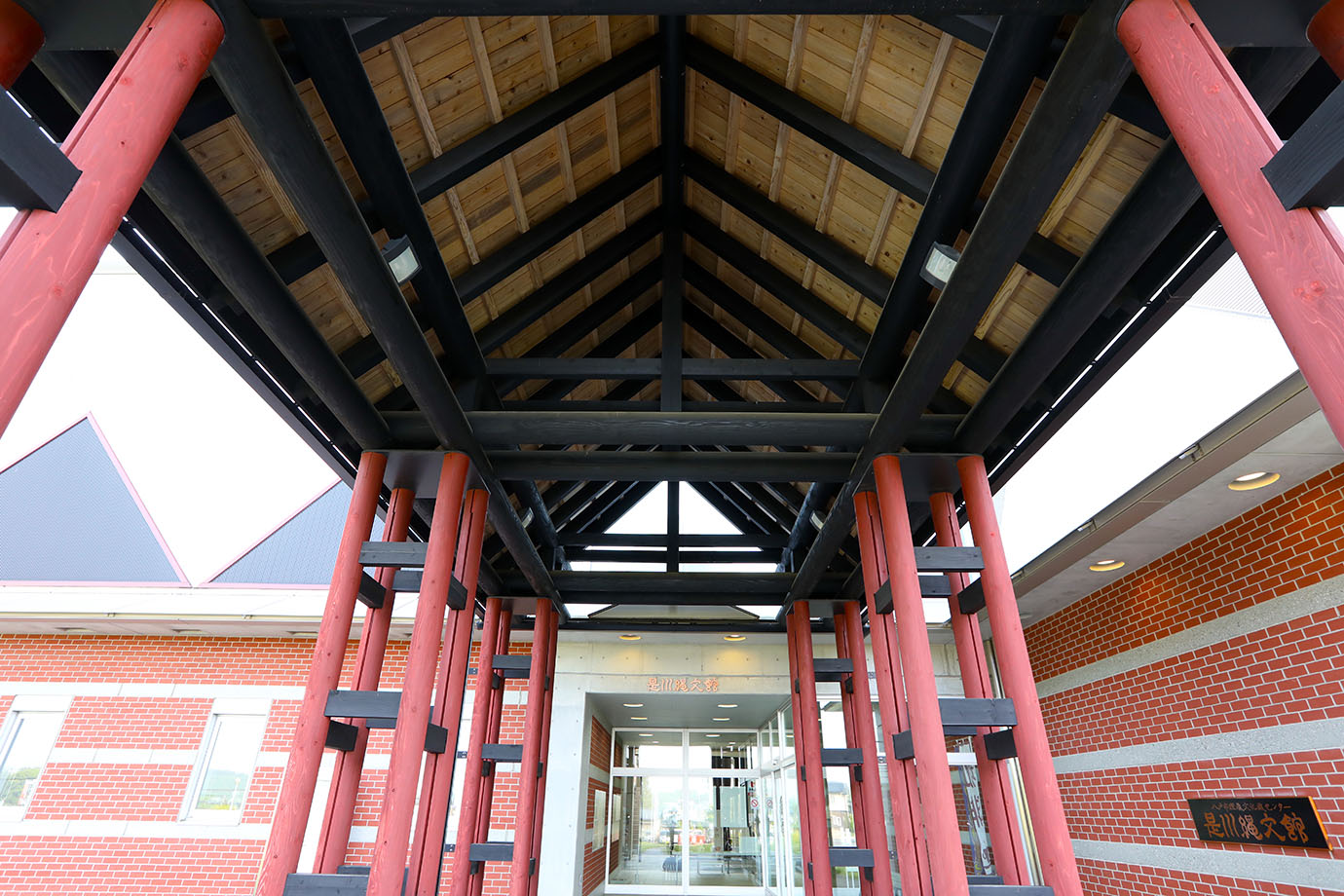
At the museum store and cafe corner on the first floor, Kore Cafe, you can purchase goods featuring designs based on the National Treasure, the "clay figurine with clasping hands," as well as goods featuring the Inorun, an original character. At the cafe corner, visitors can enjoy light meals such as Jomon Ramen, which contains noodles made with acorns, which were believed to have been eaten by the Jomon people.
Korekawa Archaeological Institution, Hachinohe City Buried Cultural Property Center
Address:1 Yokoyama, Korekawa, Hachinohe-shi, Aomori
Phone:0178-38-9511
Price:250 yen for viewing. (From July 15 to September 3, the special exhibition fee is 300 yen. Admission is free on August 20 and November 3.)
Hours:9:00 a.m. to 5:00 p.m. (Last admissions: 4:30 p.m.)
Closed:Mondays (open on national holidays and substitute holidays), New Year's holidays. (Note: Temporary closures may occur.)
Hasshoku Center
Taste produce you bought at the market cooked on a charcoal grill

This large market has been in business for more than thirty years and is home to sixty stores on a site spanning 170 meters. The products sold vary depending on the store but include fresh seafood from ports in the Hachinohe area, produce, raw meat, dry goods, and sake. It's a fun place to shop at reasonable prices.
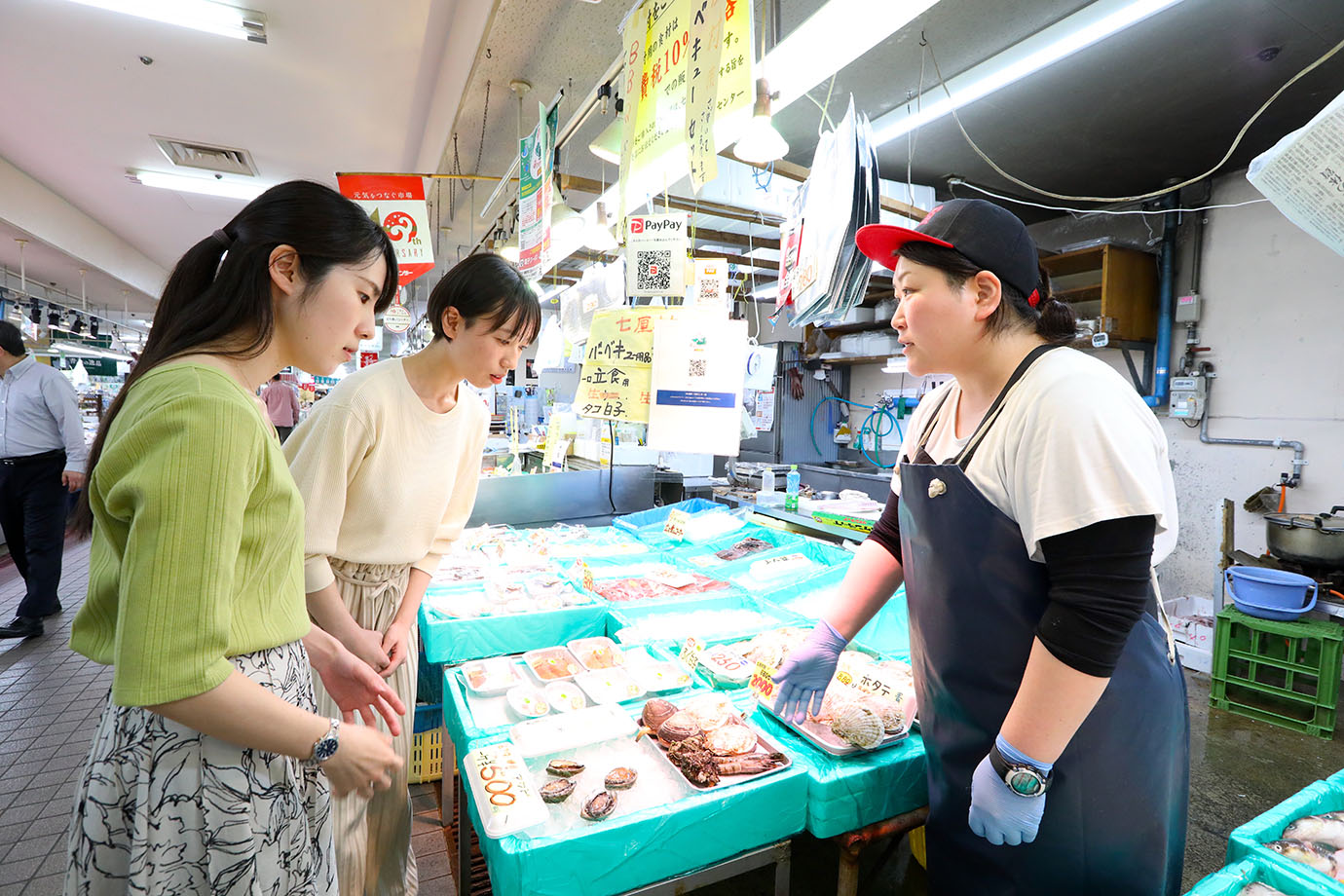
You can take the seafood and meat you purchase to Shichirin-mura, where you can cook it on a charcoal fire and eat it on the spot. As you enjoy shopping, you can take a look at all the delicious-looking products and check with the shopkeeper whether they can be grilled and eaten.

On our visit, we went to Fukushin and bought scallops, clams, and turban shells that were still moving. It was spectacular to watch the way the shopkeeper skillfully prepared them one after another with her hands.
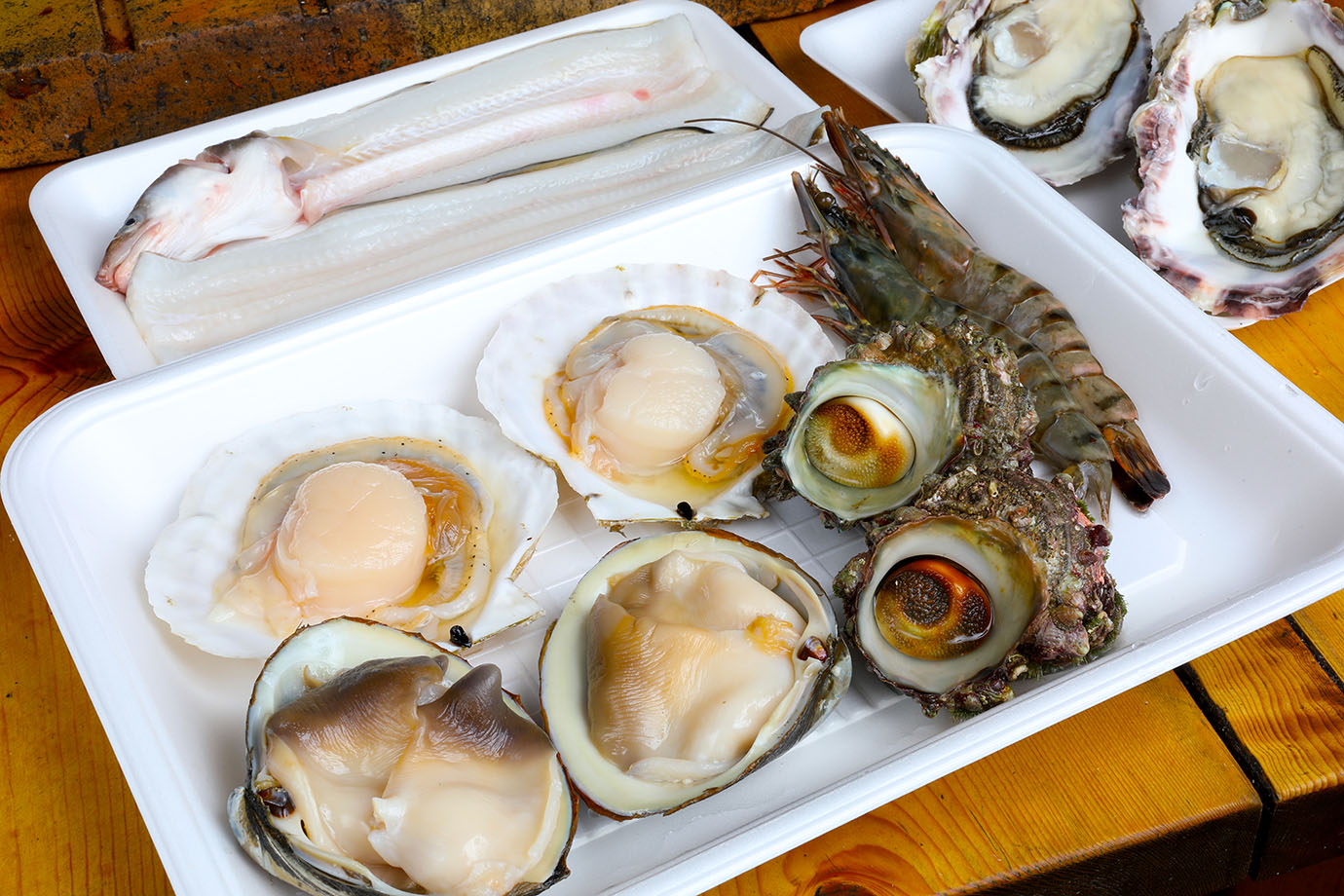
The barbecue set was 3,450 yen for two people. We cooked scallops, turban shells, oysters, and clams, as well as giant shrimp and transparent conger eel.
Which one would you eat first? It's time to dig into a meal of fresh seafood on the grill.

After paying a usage fee (400 yen per person) at the counter at Shichirin-mura, you can do the grilling yourself. After it's been grilled over a charcoal fire, the seafood is plump and juicy! Shichirin-mura also sells rice, grilled rice balls, sembei soup, and drinks.

This is a serving of nokke-don (seafood rice bowl) from Kaga Shoten. The store offers about ten different types of seafood, so you can enjoy a bowl topped with your favorite ingredients. On the day of our visit, we had a luxurious bowl with tuna, sea urchin, salmon roe, and botan shrimp for just 2,050 yen! Not only is it fresh, but it's also very affordable.
Hasshoku Center
Address:22-2 Kansai, Kawaragi, Hachinohe-shi, Aomori
Phone:0178-28-9311
Hours:9:00 a.m. to 6:00 p.m. (market building hours)
Closed:Wednesdays
Shichirin-mura
Address:22-2 Kansai, Kawaragi, Hachinohe-shi, Aomori
Phone:0178-29-4451
Fee:400 yen per person
Hours:9:00 a.m. to 6:00 p.m. (Last admissions: 5:00 p.m.)
Closed:Wednesdays
Hachinohe Portal Museum "hacchi"
A gateway that creates new attractions and draws visitors to Hachinohe

Hachinohe Portal Museum "hacchi" is a cultural and tourism exchange complex located in the center of Hachinohe City. The complex is home to a variety of establishments, including exhibits that capture the charms of Hachinohe, cafes and shops that have sprung from the love of local ingredients, and galleries and theaters that serve as places for people to carry out civic activities and for artists to come together. At the entrance, you will be greeted by 288 Yawata horses.

The "hacchi Square" on the first floor is an open space with a vaulted ceiling that goes up to the third floor. This is where events are held. The tourist exhibition corner introduces the history and technique behind Nanbu sakiori and Nanbu hishizashi, which are two local weaving traditions.
Use the loom to try your hand at traditional Nanbu sakiori!

On the fourth floor are the Arts & Crafts Studio Shops, which are dedicated to helping local artists start their own businesses. At these studios and shops, artists engage in creative activities, such as making wood toys, mosaic art, Nanbu sakiori, and more. At the Traditional Craft Booth, visitors can try their hand at making Nanbu sakiori and other fabrics, so give it a shot.

At the Nanbu sakiori weaving workshop (from 500 yen), you can weave colorful thread made from kimono scraps and old cloth into the warp thread on the loom. In about thirty minutes, your coaster will be complete. In this way, the old cloth is reborn as a lovely coaster.
Hachinohe Portal Museum "hacchi"
Address:11-1 Mikkamachi, Hachinohe-shi, Aomori
Phone:0178-22-8228
Fee:None (free admission)
Hours:9:00 a.m.-9:00 p.m. (The traditional craft experience booth is open from 10:00 a.m. to 4:00 p.m.)
Closed:Tuesdays (or the following day when Tuesday is a holiday)
Youtree Souvenir Shop
Before you get on the Shinkansen, you can pick out some souvenirs here.

Directly connected to JR Hachinohe Station by a passageway, Youtree (VISIT Hachinohe) is a complex with souvenir shops, workshop facilities, meeting rooms, and lodging facilities. On the day of our shoot, floats from the extravagant Hachinohe Sansha Taisai festival were displayed in the main hall.

Located on the first floor, the Ondeanse Youtree Souvenir Shop sells about 2,000 specialty items from all over Aomori Prefecture. There's a passage that takes you from the shop directly to the station, so you can do some shopping while waiting for the Shinkansen. There is also a Nanbu Sembei demonstration corner in one corner of the shop.

Ikazukinzu, the mascot of Hachinohe, is a black-tailed gull wearing a squid hat. A large plush toy of the character can be purchased for 2,700 yen.
Our most recommended items are delicacies and canned foods. They even have rock sugar sweets that look like jewels.

The highest-ranking souvenir is "Nakayoshi" (864 yen)! This easy-to-eat delicacy consists of cheese sandwiched between pieces of squid caught in the waters around Hachinohe. For 540 yen each, the canned mackerel that uses mackerels landed at the Hachinohe fishing port has three types: mackerel stewed in water, mackerel stewed in miso, and seasoned mackerel. With just the right amount of seasoning combined with the delicious flavor of seasonal mackerel, the level of this product is above the quality expected to canned goods.

The Nanbu Hishizashi Rock Sugar Hachinohe Kirari is 1,200 yen. Open the case that looks like a white cocoon to uncover colorful pieces of rock sugar. The rock sugar, which is made into a shape inspired by the diamond pattern seen in traditional Nanbu hishizashi crafts, has a crystalline texture and comes in a variety of flavors, including apple, apricot, carrot, and mulberry tea.

There is a section for popular souvenirs at the entrance, so don't forget to take a look. The displays are designed for easy viewing and shopping. There's even a sake-tasting corner that offers local brands of sake that are hard to come by, even in Japan.
Ondeanse Youtree Souvenir Shop
Address:1-9-22 Ichibancho, Hachinohe-shi, Aomori
Phone:0178-22-2227
Hours:9:00 a.m.–6:00 p.m.
Closed:Open every day

JR-EAST HOTEL METS
Reception staff

JR-EAST HOTEL METS HACHINOHE
Staff at General Affairs Dept.
(Morioka Terminal Building co.,Ltd.)

JR-EAST HOTEL METS HACHINOHE
The shop is directly connected to Hachinohe Station on the Tohoku Shinkansen line. We guarantee a comfortable stay that will serve as your gateway to sightseeing in Aomori Prefecture or as your base for business in the Hachinohe area.
NotesOpenClose
*Information provided on this website is current as of July 2023. The featured facilities may change their fees, hours, days closed, menus, and other information after it has been published here, or they may be temporarily closed. Although every effort has been made to ensure the accuracy of the content on this website, including all times, fees, etc., we recommend that you contact the facility by phone or other means to get further information or make a reservation in advance. We will not be held liable for any damage in connection with the content of this website.
*All charges and fees shown on this website include consumption tax and were current at the time the information about them was collected. Facilities that offer dine-in and/or takeout services are so noted in the articles. Charges and fees are subject to change.
*Facility schedules do not reflect closures during the year-end/New Year holidays, Bon festival, and Golden Week as well as temporary closures unless specified by the respective facilities featured on this website.
*Operating hours shown on this website are generally the hours from opening to closing unless otherwise specifically noted. Last orders and entries are usually accepted 30 minutes to 1 hour before closing.
SHARE

